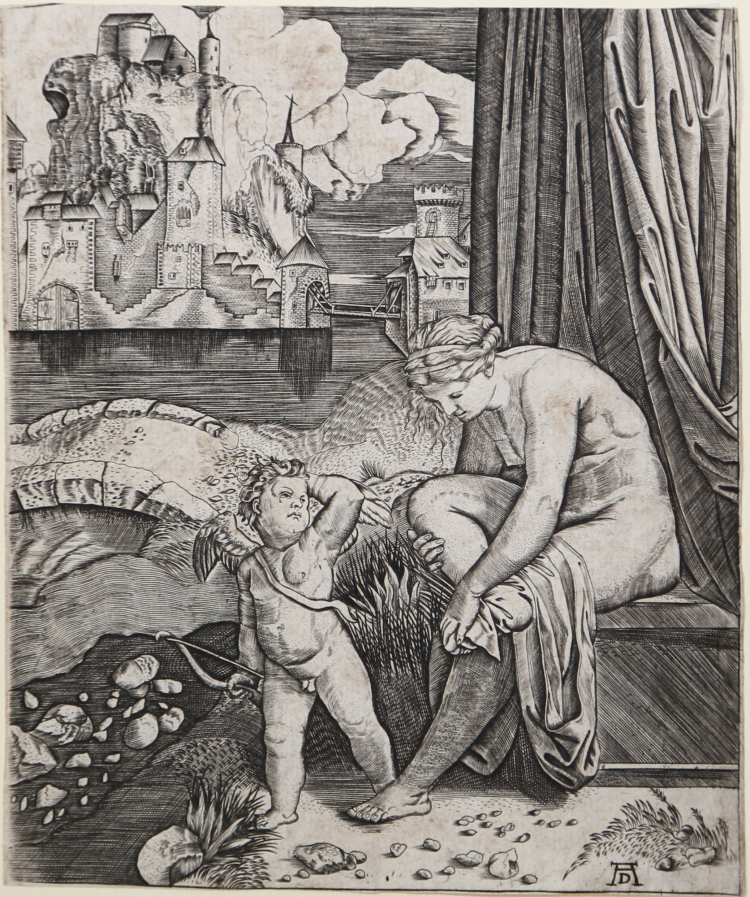




| Reference: | S32026 |
| Author | Scuola di Marcantonio Raimondi |
| Year: | 1520 |
| Measures: | 164 x 196 mm |



| Reference: | S32026 |
| Author | Scuola di Marcantonio Raimondi |
| Year: | 1520 |
| Measures: | 164 x 196 mm |
Engraving, about 1520-30, unsigned. Single state.
A good proof, printed on contemporary laid paper, trimmed to copperplate, restoration at upper right corner perfectly executed, otherwise in excellent condition.
Copy in reverse after Marcantonio Raimondi, with a landscape setting in place of the room with a window. The buidings in the background are suggested by those in Dürer’s Hercules of about 1500, the stone bridge and stream with stones on the bank are copied from Dürer’s Virgin and Child with the Monkey of about 1498.
It is thought that the subject of the engraving may be the seventh scene, lost, on the north wall of the Stufetta by Cardinal Bibbiena, decorated by Raphael and his circle with episodes from the life of Venus.
About identification with the lost scene of Bibbiena, see. Oberhuber, p. 335 And Mason 335, n. 69.
Raimondi’s engraving is available in several replicas that attest to the vast success, including that of Altdorfer.
The scene is of a delicate refinement: Venus sitting, naked, with a sweet and thoughtful, is leaning forward in the act of wiping foot with a robe. Beside her, standing is winged Cupid with his bow in his left hand and the right hand between the curls. From the window behind them, you can see a hilly landscape. The draping on the left, with its folds, gives spatial depth to the scene.
Bibliografia
Barstch: XIV, p. 224; Delaborde, p. 161 n. 115; Hind, V, n. 44; Passavant, III, p. 281 n. 43; Raphael Invenit, p. 63 n. VII. 4.
Scuola di Marcantonio Raimondi
|
Marcantonio Raimondi is considered the greatest engraver of early Renaissance and the first to spread the work of Raphael. He was born in San’Andrea in Argine, near Bologna. His first artistic apprenticeship took place in Bologna, around 1504, in the workshop of Francesco Francia, painter and goldsmith.
His first known engraving is dated 1505. In 1506 he went to Venice to live and work; in this year, he started developing his own personal style for, in his production that period, is quite evident the influence of Mantegna and Dürer. According to Vasari, Raimondi met Dürer in Venice, for they were both living there at the same time, but they had a quarrel over the reproductions, on copper, of Dürer’s seventeen woodcuts of the Vita della Vergine. After 1507, he turned to different models, especially those coming from Rome and Florence. He was in Rome in 1509, where he was introduced into the circle of the most important artists working in the City, such as Jacopo Rimanda from Bologna. In the same year he met Rapahel in the workshop of Baviera; the following year Raimondi became popular as the main interpreter of Raphael’s paintings. The Lucrezia can be considered the starting point of their cooperation and a sort of second beginning for Raimondi’s new style. In any case, together with the engravings representing Raphael’s works, Raimondi went on with the publication of his own subjects, especially antiquity, whose influence can be seen in his whole production (cfr. Dubois-Reymond 1978).
Between 1515-1516 Marcantonio started showing a keen interest for chiaroscuro, maybe under the influence fo Agostino Veneziano and Marco Dente, from Baviera’s workshop.
Till Raphael’s death, in 1520, Raimondi worked and lived in the background of the great artist from Urbino and engraved his works and those of his scholars.
His business went down after the Sacco (sack) Di Roma in 1527, when he was obliged to pay a huge amount of money to the invaders of the City to save his life.
He died in Bologna before 1534, in complete misery.
|
Scuola di Marcantonio Raimondi
|
Marcantonio Raimondi is considered the greatest engraver of early Renaissance and the first to spread the work of Raphael. He was born in San’Andrea in Argine, near Bologna. His first artistic apprenticeship took place in Bologna, around 1504, in the workshop of Francesco Francia, painter and goldsmith.
His first known engraving is dated 1505. In 1506 he went to Venice to live and work; in this year, he started developing his own personal style for, in his production that period, is quite evident the influence of Mantegna and Dürer. According to Vasari, Raimondi met Dürer in Venice, for they were both living there at the same time, but they had a quarrel over the reproductions, on copper, of Dürer’s seventeen woodcuts of the Vita della Vergine. After 1507, he turned to different models, especially those coming from Rome and Florence. He was in Rome in 1509, where he was introduced into the circle of the most important artists working in the City, such as Jacopo Rimanda from Bologna. In the same year he met Rapahel in the workshop of Baviera; the following year Raimondi became popular as the main interpreter of Raphael’s paintings. The Lucrezia can be considered the starting point of their cooperation and a sort of second beginning for Raimondi’s new style. In any case, together with the engravings representing Raphael’s works, Raimondi went on with the publication of his own subjects, especially antiquity, whose influence can be seen in his whole production (cfr. Dubois-Reymond 1978).
Between 1515-1516 Marcantonio started showing a keen interest for chiaroscuro, maybe under the influence fo Agostino Veneziano and Marco Dente, from Baviera’s workshop.
Till Raphael’s death, in 1520, Raimondi worked and lived in the background of the great artist from Urbino and engraved his works and those of his scholars.
His business went down after the Sacco (sack) Di Roma in 1527, when he was obliged to pay a huge amount of money to the invaders of the City to save his life.
He died in Bologna before 1534, in complete misery.
|